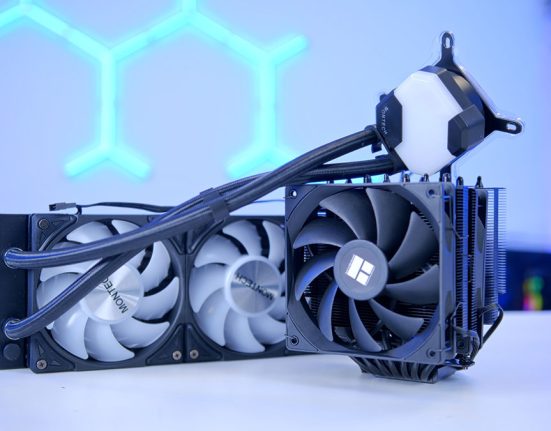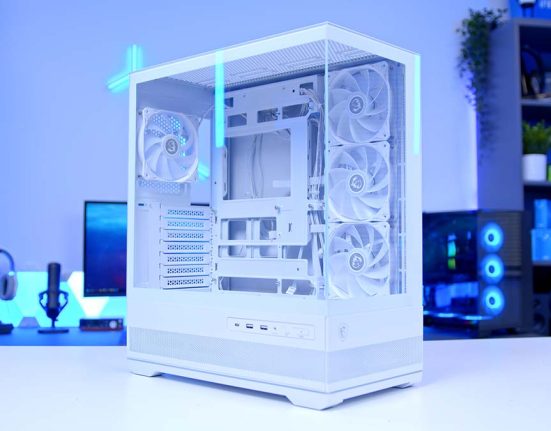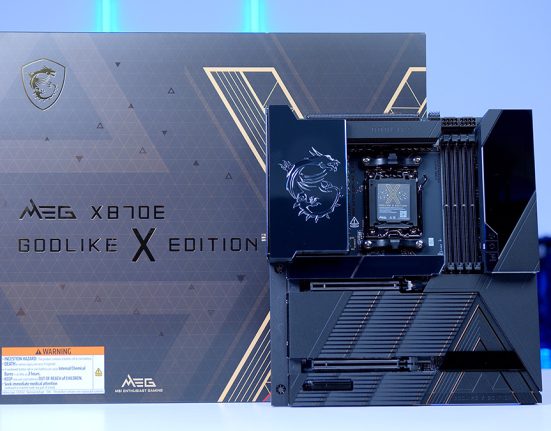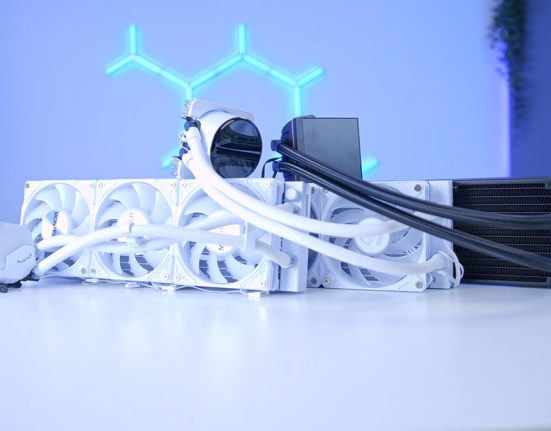The MSI Z790 PROJECT ZERO motherboard is MSI’s intuitive solution to the consistent pain of cable management. PROJECT ZERO is the MSI branding for their reverse connector motherboards, where all headers and cabling have shifted to the back of the PCB. We’ve previously reviewed the B650M PROJECT ZERO board on the AMD Ryzen 7000 platform, so we’ve rigorously tested the Z790 PROJECT ZERO to see how they differ.
This design shift allows PC builders to configure an immaculate system with no visible cables at the front of the case apart from the graphics card power. The Z790 PROJECT ZERO is a DDR5 ATX motherboard offering a solid power solution for CPU overclocking, a bountiful set of rear IO including support for WiFi 7, and a sleek silvery heatsink design that looks great in a white-themed PC build.
In this review, we’ll assess the specs, design, and features to see how the Z790 PROJECT ZERO compares to other reverse cable motherboards on the market, alongside similarly priced options, to see if this board is a worthwhile pickup.
Buy the MSI Z790 PROJECT ZERO on:
Specification
On paper, the MSI Z790 PROJECT ZERO offers a decent set of specs and aligns more with the mid-range market regarding features. Utilising an ATX form factor, the MSI Z790 PROJECT ZERO supports up to 256GB of DDR5 RAM, which can be overclocked up to 7200MT/s. Additionally, this board offers a 14+1+1 VRM power phase design, which can handle a light overclock on your Intel CPU.

On the expansion front, the Z790 PROJECT ZERO features a singular Gen5 PCI-E x16 slot for the next generation of graphics cards and comes with four Gen4 M.2 slots for future storage upgrades. Admittedly, it’s disappointing that there’s no Gen5 support for SSDs, especially as these drives have saturated the market over the past year.
| Specification | MSI Z790 PROJECT ZERO |
|---|---|
| Form Factor | ATX |
| Supported Memory | 256GB DDR5 7200MT/s |
| PCI-E x16 Slots | 1 x PCI-E 5.0 1 x PCI-E 4.0 |
| PCI-E x4 Slots | 4 x PCI-E 4.0 |
| VRM Power Phases | 14+1+1 |
| Front IO | 2 x USB 3.2 Gen1 1 x USB 3.2 Gen2 Type-C 2 x USB 2.0 |
| Rear IO | 4 x USB 2.0 2 x USB 3.2 Gen1 Type-A 1 x USB 3.2 Gen2 Type-A 1 x USB 3.2 Gen2x2 Type-C |
| Audio | 6 x Audio Jacks |
| Networking | 2.5 Gigabit LAN WiFi 7 |
Regarding IO, there are five headers for front panel case ports. These comprise two USB 2.0 headers, two USB 3.2 Gen1 headers (both supporting two USBs each), and a single USB 3.2 Gen2 Type-C header. Rear IO is slightly weaker, with eight ports in total, half of which are USB 2.0 ports. The remaining USB ports are USB 3.2 Gen1 or higher, with a 20Gbps Type-C available.
I’m not a fan of USB 2.0 on mid-range boards, primarily because there are other boards we’ve looked at that offer a better selection of IO. But to play devil’s advocate, having eight ports is better than four, so they’re a valuable addition. Also, on the rear IO, you’ll find six audio jacks that are ideal for those with dedicated speaker setups. Additionally, this board offers 2.5 Gigabit LAN and WiFi 7 for networking, providing blazing-fast speeds and reliability if you have a supporting router.
At $279.99, the MSI Z790 PROJECT ZERO is somewhat pricier than other mid-range boards. However, as a reverse connector motherboard, the Z790 PROJECT ZERO has a comparatively better price than some ASUS BTF options. Regardless, I don’t feel the cost of this motherboard is entirely outlandish, considering all of the headers have been shifted to the back of the PCB.
Suggested Article: The Best $2000 Zero-Cables PC Build
What is PROJECT ZERO?
As we’ve alluded to in the intro, the PROJECT ZERO branding is MSI’s approach to simplifying cable management by shifting all headers, power, fan, USB, and front panel to the back of the PCB. MSI isn’t the only manufacturer offering these reverse connector motherboards, as ASUS and Gigabyte have alternative approaches that hide messy cables. ASUS BTF (or Back To the Future) is quite popular as their boards hide away GPU cabling, providing a way to build a genuinely cable-free system.
Shifting the power connectors and headers to the back of the motherboard keeps them away from the front of the case, keeping any mess out of sight. Furthermore, it makes cable management much more straightforward as they don’t need to be threaded through cutouts at the front of the case; everything can be done at the back.

It’s worth noting that while this innovative design is an excellent solution to the bane of cable management, these boards require a proprietary case to be paired alongside them. While many manufacturers have provided new cases to supplement this, such as Corsair’s 2500 and 6500 range or the Thermaltake Ceres 330, we’re not likely to see this standard become the norm for some time.
For this reason, cases supporting PROJECT ZERO motherboards are pricier than their non-PROJECT ZERO counterparts, significantly raising build costs. However, after reviewing a number of these cases and building with them, the benefit of being able to build a super-clean system is often worth the extra cost.
What’s in the Box?
All motherboard manufacturers often include additional accessories and items in the motherboard box that can ease the building process or offer additional quality-of-life features. The MSI Z790 PROJECT ZERO comes with a few extras that are worth taking a look at.
The first accessory in the box is an installation guide with various QR codes for different language manuals. If you’ve never built a PC before, this manual can be handy as it tells you what plugs in, where, and what each slot is for.

Strangely, MSI has included a driver installation DVD, which is odd. However, for those with a disc drive in their case, this DVD could be helpful to get any necessary drivers installed. Those without a disc drive will need to go to the Z790 PROJECT ZERO product page on MSI’s website and download any necessary drivers from the ‘Support’ tab.
As this motherboard has built-in WiFi, an included set of antennas must be plugged into the rear IO to provide better speeds and additional range.

There are two SATA data cables in a small plastic bag. These will be needed for those with any SATA hard drives or SSDs, so it’s helpful that MSI has included them for older storage media.

For those with M.2 drives, MSI has provided their EZ M.2 clips, which make installing an NVMe SSD much simpler. These can be screwed into the board to replace standard M.2 screws.

Finally, a small booklet of stickers can be used to label up any cables in your build or to personalise your case, desk, or peripherals.

MSI Z790 PROJECT ZERO Design
The MSI Z790 PROJECT ZERO sits inside a specialised box designed to house the board with space for the reverse connectors. Upon taking this board out of its box, you’re greeted with a sleek set of brushed metal heatsinks atop a black PCB. Not too dissimilar from the B650M PROJECT ZERO, the heatsinks don the PROJECT ZERO branding and feature some grey and black stripes, adding a splash of colour to the aesthetic.

Compared to the B650M PROJECT ZERO, this Z790 variant has a larger surface area of heatsink that covers the barebones look of the PCB. However, as this is an ATX board with more PCI-E x16 slots, MSI has opted to provide more unscrewable heatsinks that cover the SSD slots instead of one large piece of metal, which is what we saw on the B650M board. The sheer amount of metal on this board provides a more premium look while maintaining a clean design, which is the primary purpose of these boards.

Further adhering to the idea of a clean design, the MSI Z790 PROJECT ZERO comes with no additional RGB lighting strips on the board. While some may prefer this, I feel some extra lighting, such as a white strip of LEDs, would enhance the look of this board, taking a similar approach to MSI’s very own SUPRIM X graphics cards.

But despite this, the overall design is exceptionally tidy. My only wish for PROJECT ZERO boards is for MSI to provide a solution to GPU cabling. While any PC build using this motherboard will look highly sophisticated, the addition of a GPU cable is a pet peeve that makes the ASUS BTF boards a better solution for those striving to configure the ultimate no-cables PC.
Connectivity Options
Graphics Card Slot
The MSI Z790 PROJECT ZERO has three full-length PCI-E x16 slots, but only the top slot utilises the full x16 bandwidth. The primary GPU slot on this motherboard is Gen5 ready, supporting the next generation of graphics cards. It doesn’t make sense to me for this slot to support Gen5 speeds because these cards don’t exist yet at the time of writing.

However, much like all other brands that have released motherboards in the past year or two, the Z790 PROJECT ZERO offers some future-proofing for those planning to upgrade.
M.2 Slots
The Z790 PROJECT ZERO has four Gen4 M.2 slots for storage options. Two of these are located underneath the large heatsink strip towards the bottom of the board, while the other two are separated, with one in between PCI-E slots one and two and the other above the primary graphics card slot.
Again, it’s disappointing that there’s no support for Gen5 SSDs on this motherboard. While these are primarily geared towards enthusiast PC builds, they offer exceptional speeds for those who need the performance. It also makes more sense for this board to provide bandwidth for components you can buy instead of a future generation of graphics cards.
RAM DIMMs
As stated in this article’s ‘Specification’ section, the Z790 PROJECT ZERO supports a maximum RAM capacity of 256GB with speeds up to 7200MT/s. RAM speeds are slightly weaker on this Z790 motherboard compared to the B650M PROJECT ZERO, which is a constraint of the Intel platform rather than an issue with the board itself. Regardless, the supported speeds of this board are more than ample to squeeze out some extra performance.

Rear IO
The MSI Z790 PROJECT ZERO rear IO ports aren’t remarkably impressive for a mid-range motherboard. The primary makeup of the rear IO is four USB 2.0 ports, half of the eight in total. The four additional ports, however, are all high-speed options, comprised of two USB 3.2 Gen1 Type-A ports, a USB 3.2 Gen2 Type-A port, and a USB 3.2 Gen2x2 Type-C port rated at 20Gbps.

For networking, you can choose between 2.5 Gigabit LAN, a standard offering for most mid-range boards, or WiFi 7. While the support for WiFi 7 is appreciated, the vast majority of prospective buyers aren’t likely to have a supported router, so the inclusion of this new tech will be a bit pointless for some.
This board also comes with a full suite of six 3.5mm audio jacks, ideal for those with speaker setups or content creators needing extra audio inputs and outputs. MSI has also included a BIOS flash button, which can quickly solve some software issues when building.
Internal Headers
CPU and Motherboard Power
Moving around to the rear of the PCB, the MSI Z790 PROJECT ZERO has a relatively standard CPU and motherboard power configuration. There are two 8-pin EPS connectors for the CPU at the top right of the board, which must be plugged in for any overclocking.

On the left side of the board is the motherboard power connector, which uses the universal 20+4-pin standard. On other boards, you may find the motherboard power split into two ports, but MSI has kept things simple by using the common 24-pin header.

Front USB Headers
All of these headers connect up to the IO on your case. It’s worth noting that all cases differ regarding USB ports, so not all of these headers are necessary for the front IO to function fully.
The USB headers on this board are spaced out across the bottom and the side of the PCB. At the bottom are two USB 2.0 headers supporting four USB 2.0 ports. There is also a USB 3.0 header next to the second USB 2 header, which supports up to two USB 3.2 Gen1 Type-A ports.

On the left side of the PCB, just underneath the motherboard power header, are the USB 3.0 header and USB-C header, which support a USB 3.2 Gen2 port rated up to 10Gbps.

Front Panel Power (JFP1)
The front panel power header is in its usual place, at the bottom left of the motherboard (this would be the bottom right if we flipped the motherboard over). Plugging in front panel power is often the most finicky part of any build, primarily because the pins are so small and fragile.
As a general rule of thumb, we recommend getting all of the JFP1 headers plugged in to save hassle. But you can plug in the ‘PWR_SW’ pins to save some time if HDD and Reset aren’t needed.
Pump and Fan Headers
For fan headers, this board spoils you for choice. There are five system fan headers, an AIO pump header, and a CPU fan header. Most of these are located at the top of the PCB, with the pump, CPU and first three system fan headers at the top left.

The rest of the system fan headers line the bottom of the motherboard, with one above the first USB 2.0 header and the other two sitting towards the right of the USB 3.0 connector.

RGB Headers
The support for RGB is somewhat lacking on this motherboard. The MSI Z790 PROJECT ZERO has two 3-pin addressable RGB headers at the top right and bottom right of the PCB and an additional 4-pin non-addressable RGB header at the top left.

While addressable RGB is a premium feature, we feel that the Z790 PROJECT ZERO should have more headers to choose from as a premium motherboard. The B650M PROJECT ZERO board we’ve reviewed previously offers an additional RGB header, so it’s a shame that MSI hasn’t provided more options for this pricier board.
SATA Data Ports
Compared to the B650M PROJECT ZERO, the Z790 PROJECT ZERO board has additional PCB room for more ports. For this reason, there are six SATA data ports instead of four. While SATA data isn’t as necessary due to the rise of NVMe SSDs, it’s excellent that MSI still offers ample options for older storage devices.

Building with the Z790 PROJECT ZERO
Initially, building with PROJECT ZERO motherboards can be pretty complicated. Compared to traditional PC builds, the motherboard enters the case first without socketing the CPU or installing the RAM, SSD, or CPU cooler. Getting the board into the case is relatively easy, but we advise caution to ensure the headers aren’t damaged as they go through the cutouts.

We installed the Z790 PROJECT ZERO inside the MSI MEG MAESTRO 700L PZ case, which made the building process slightly more complicated due to the unibody design. However, once the motherboard was secured, the build was relatively seamless.
Once it got to a point where we could do cable management, we started to see the returns of using a PROJECT ZERO motherboard. Having all the power cables and headers poke through the back of the case made plugging everything in incredibly simple. All main power headers are accessible and easily managed with cable ties.

After getting everything plugged in, the build looked excellent. The MSI MEG MAESTRO 700L PZ is an immaculate case, and the lack of cables at the front of the chassis made the build look great. The only point of contention we have is the graphics card cable. The GPU power popping up at the front of the chassis takes away from the no-cables build. While I don’t feel the overall aesthetic is ruined, we’ve achieved tidier builds with ASUS BTF boards, which also have a solution for graphics cards.
While we’re not saying the Z790 PROJECT ZERO is a lousy board because of the GPU cabling, it could be worth looking at ASUS BTF alternatives for those striving to build an immaculate system.
Features We Like
Reverse Connectors Design
PROJECT ZERO motherboards are a force for good, and this unique design change is beneficial and alleviates the hassle and stress of cable management. Shifting all the connectors to the back of the boards results in an immaculate PC build, making cables much more presentable than traditional motherboards.

Vast Amount of Fan Headers
This motherboard has five fan headers, which isn’t a standard feature. More fan headers are great because they allow those without adapters or a fan and RGB hub to plug in fans without issue. Not all coolers and cases come with a hub, so more headers provide better options for those with plenty of fans or coolers.

Features We Don’t Like
Weak Selection of USB Ports
While the rear IO isn’t poor on the whole, I feel the selection of USB ports could be better. As a premium mid-range motherboard, we expected a more robust selection of high-speed options, so seeing so many USB 2.0 ports is a shame.

Conclusion
MSI Z790 PROJECT ZERO
Product Name: Z790 PROJECT ZERO
Brand: MSI
-
Features
-
Design
-
Performance
-
Value For Money
Summary
The MSI Z790 PROJECT ZERO is a fantastic motherboard that alleviates the hassle of cables and wiring by shifting all headers to the back of the PCB. In doing this, any build with this board will look incredibly clean and simplify the process of managing cables, as there’s plenty of slack and clearance to get cables tied up exactly how you want them. The Z790 PROJECT ZERO also offers a solid set of networking options, a sophisticated, light-themed design, and ample connectivity for future upgrades.
While this is a pricey motherboard, compared to traditional options we’ve looked at, the zero-cables design is well worth the additional cost. Our only major qualm with this board is that MSI has provided no solution to graphics card cabling. This means that about 98% of your cables will be hidden while the GPU cable is still visible. This doesn’t ruin this board’s tidy aesthetic, but it means that ASUS BTF motherboards may be a better alternative for those looking to build a genuinely cable-free PC.
Pros
✅ Sleek aesthetic
✅ Reverse connectors design
✅ Ample fan headers
Cons
❌ Rear USB ports
❌ No Gen5 SSD support
❌ No hidden GPU power


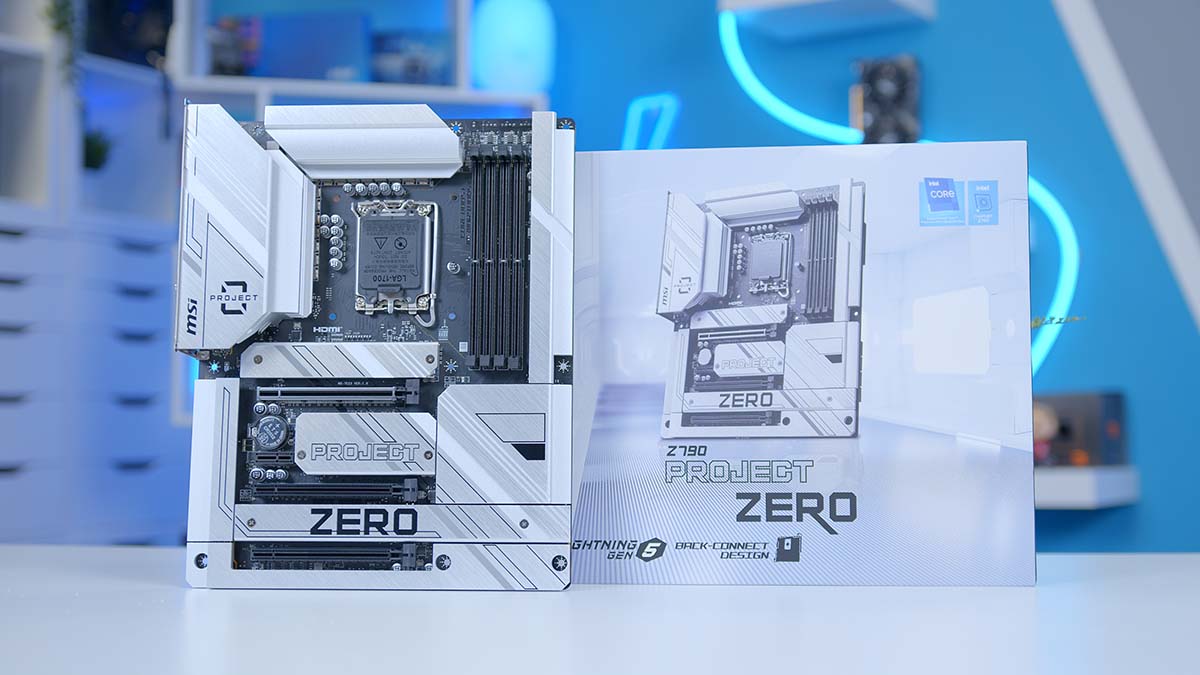

![FI_[DP056] Antec flux M + 9060XT](https://geekawhat.com/wp-content/uploads/2025/12/FI_DP056-Antec-flux-M-9060XT-551x431.jpg)
